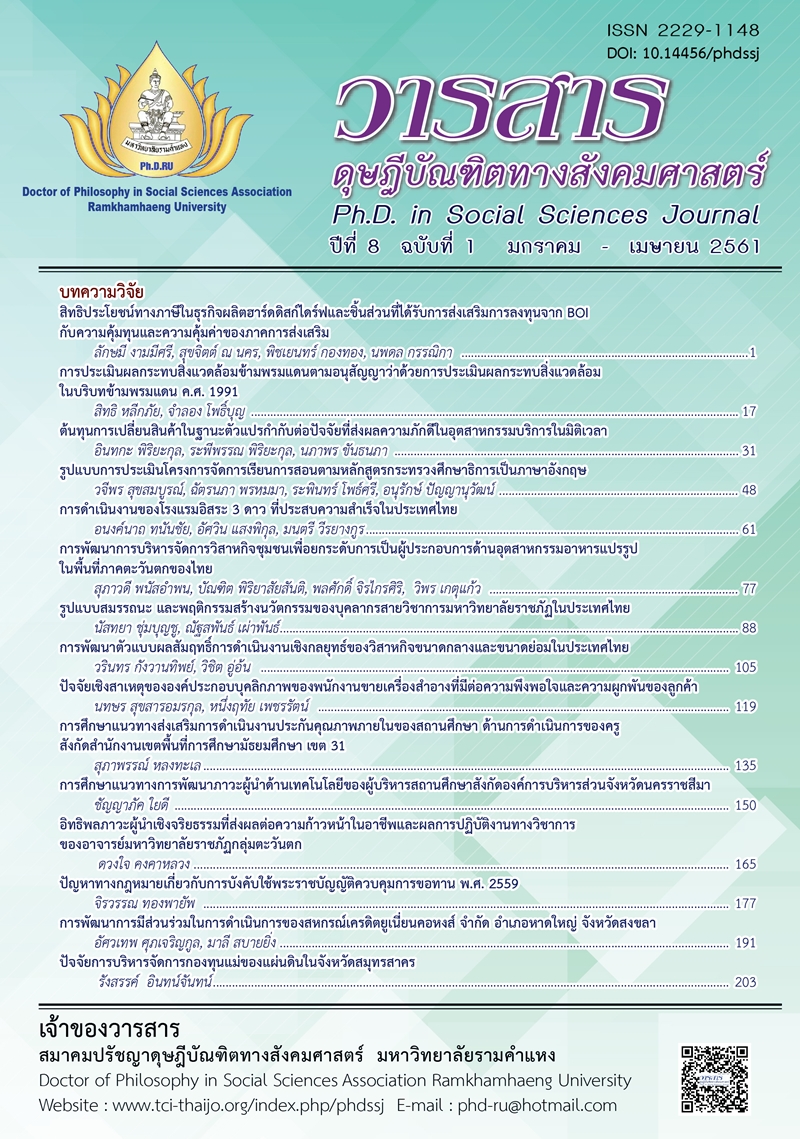DEVELOPMENT MODEL OF THE STRATEGIC ACHIEVEMENT PERFORMANCE FOR SMALL AND MEDIUM ENTERPRISES IN THAILAND
Main Article Content
Abstract
This research is Development Model of the Strategic Achievement Performance for Small and Medium Enterprises in Thailand, this is the Mix Methods Research as the Qualitative Research and Quantitative Research. These aims are (1) to study the cause factors impact the strategic achievement performance for small and medium enterprise in Thailand (2) to study both of direct and indirect influence of size and total influences of cause factors impact on strategic achievement performance for small and medium enterprise in Thailand (3) to audit the symphony of structural equation modeling of strategic achievement performance for Small and Medium Enterprise in Thailand to developed with empirical data and (4) to develop model of strategic achievement performance for Small and Medium Enterprise in Thailand by data collection from quantitative by questionnaire from 800 samplings group and qualitative by depth interview SMEs entrepreneur in Bangkok and surrounding areas for 5 entrepreneurs with using data analysis and analysis technique Structural Equation Model.
Research result found that business environment when considered the perspective found that it was agreement level ( = 3.65, SD = 0.487) as adjustment of the executive level in overall found that agreement level (
= 3.96, SD = 0.565) particularly concerning the adjustment was highest level (
= 4.11, SD = 0.650) and organization structure when concerned in the big picture found that middle level (
= 3.33, SD = 0.450) especially specialist structure which was in the overview found that was highest level (
= 3.44, SD = 0.652) in addition business environment of adjustment of executive level had positive indirect influence the business operation that had value of statistical significant level .01
Article Details
Academic articles, research articles, and book reviews in the Ph.D. in Social Sciences Journal are author’s opinions, and not the publisher’s, and is not the responsibility of the Ph.D. in Social Sciences Journal Philosophy Association, Ramkhamhaeng University. (In the case that research is done on human, the researcher has to be trained in Ethics for Doing Research on Human Training and has to produce the evidence of the training).
References
Anderson, C., & Paine, F. (1975). Managerial perceptions and strategic behavior. Academy of Management Journal, 18(4), 811-823.
Barnard, C. (1938). Functions of the executive. Cambridge, MA: Harvard University Press.
Bart, C. K., & Baetz, M. C. (1998). The relationship between mission statements and firm performance: An exploratory study. Journal of Management Studies, 35(6), 823-853.
Chandler, A. (1962). Strategy and structure. Cambridge, MA: MIT Press.
Davis, D., Morris, M., & Allen, J. (1991). Perceived environmental turbulence and its effect on selected entrepreneurship, marketing and organizational characteristics in industrial firms. Journal of the Academy of Marketing Science, 19(1), 43-51.
Dill, W. (1958). Environment as an influence on managerial autonomy. Administrative Science Quarterly, 2(4), 409-443.
Eisenhardt, K. (1989). Making fast strategic decisions in high-velocity environments. Academy of Management Journal, 32(3), 543-576.
Ghoshal, S., Korine, H., & Szulanski, G. (1994). Interunit communication in multinational corporations, Management Science, 40(1), 96-110.
Greenley, G. E. (1995a). Forms of market orientation in UK companies. Journal of Management Studies, 32(1), 47-66.
Kohli, A., & Jaworski, B. (1990). Market orientation: The construct, research propositions, and managerial implications. Journal of Marketing, 54(2), 1-18.
Klinhom, W. (2014). Enterprise organization management for SMEs. Retrieved June 14, 2016, from https://www.collinsconners.com/p/74 [In Thai]
Lawrence, P., & Lorsch, J. (1967). Organization and environment. Boston: Harvard Business School.
Lorsch, J., & Morse, J. (1974). Organizations and their members. New York: Harper and Row.
Ministry of industry. (2011). Master Plan for Thai industrial development 2012-2017. Retrieved June5, 2016, from https://www.oie.go.th/sites/default/files/attachments/industry_plan/National_Industrial_Development_Master_Plan.pdf [In Thai]
Narver, J., & Slater, S. (1990). The effect of a market orientation on business profitability. Journal of Marketing, 54(4), 20-35.
Nontapantawat, N. (2007). The meaning of the word entrepreneur or owner. Retrieved May 21, 2011, from https://www.ryt9.com/s/ryt9/105366 [In Thai]
Ruekert, R., Walker, O., Jr., & Roering, K. (1985). The organization of marketing activities: A contingency theory of structure and performance. Journal of Marketing, 49(1), 13-25.
Rumakom, P. (1995). Small business administration (4th ed.). Bangkok: Physicscenter. [In Thai]
Siguaw, J. A., Brown, G., & Widing, R. E. I. (1994). The influence of the market orientation of the firm on sales force behavior and attitudes. Journal of Marketing Research, 31(1), 106-116.
Small and Medium Enterprises Promotion Act, 2000. (n. d.). Promotion and support of the government. Retrieved May 5, 2016, from https://www.baanjomyut.com/library/law/02/179.html [In Thai]
Srimungkhun,S., & Pornpoltam, B. (2015). Concept of quality management of state enterprise from theory to practice in MCOT Public Company Limited. Ph.D. in Social Sciences Journal, 5(3), 14-30. [In Thai]
Tirakanan, S. (2003). Project evaluation: A practical guide. Bangkok: Chulalongkorn University Press. [In Thai]
Thoucharee, S. (2011). Change management strategy for the good of the organization. Retrieved June 5, 2016, from https://www.thailandindustry.com/indust_newweb/articles_preview.php?cid=7717 [In Thai]
Wangtan, S. (2017). Thai SMEs need the most capital for business development. Retrieved July 12, 2017, from https://www.manager.co.th/Smes/ViewNews.aspx?NewsID=9600000068461 [In Thai]
Yasai-Ardekani, M., & Haug, R. S. (1997). Contextual determinants of strategic planning processes. Journal of Management Studies, 34(5), 729-767.

